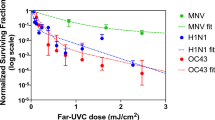Abstract
Communities have had to make concerns when and how schools serving students in schools and campus should re-open against temporary closure to slow the spread of COVID-19 virus. Apart from continuing COVID-19 health protocols for all students, teachers and staffs, technology support needed for air circulation disinfection in crowded and inadequately ventilated space like a classroom. This study examines the impact of using UVC tools and combine with evidence-based source control practices, whether refine indoor air quality to best minimize exposure risk to COVID-19 for staff and students. This study found airborne disinfection can be solved through UVC irradiation with measured radiation 7,31 mW/cm2 since previous published research only need 5 mW/cm2 at least one second. The recommendation from this study, government need to raise public policy for education institutions to apply ultraviolet germicidal irradiation (UVGI) chamber to cut-off virus airborne transmission by circulating and disinfect indoor air during in-class activities all day long.
Access this chapter
Tax calculation will be finalised at checkout
Purchases are for personal use only
Similar content being viewed by others
References
Kutter JS, Spronken MI, Fraaij PL et al (2018) Transmission routes of respiratory viruses among humans. Curr Opin Virol 28:142–151
Tellier R, Li Y, Cowling BJ et al (2019) Recognition of aerosol transmission of infectious agents: A commentary. BMC Infect Dis 19(1):101
WHO (2020) Transmission of SARS-CoV-2: Implications for infection prevention precautions. http://www.who.int/news-room/commentaries/detail/transmission-of-sars-cov-2-implications-for-infection-prevention-precautions
Griffiths (2020) Signify and Boston University validate effecIveness of signify’s UV-C light sources on inacIvaIng the virus that causes COVID-19
Conner-Kerr TA, Sullivan PK, Gaillard J, Franklin ME, Jones RM (1998) The effects of ultraviolet radiation on antibioticresistant bacteria in vitro. Ostomy Wound Manage 44:50–56
Budowsky EI, Bresler SE, Friedman EA, Zheleznova NV (1981) Principles of selective inactivation of viral genome. I. UV-induced inactivation of influenza virus. Arch Virol 68:239–247
Setlow RB, Grist E, Thompson K, Woodhead AD (1993) Wavelengths effective in induction of malignant melanoma. Proc Natl Acad Sci USA 90:6666–6670
Balasubramanian D (2000) Ultraviolet radiation and cataract. J Ocul Pharmacol Ther 16:285–297
Hoang A, Heming A (2021) Preparation in the pandemic: How schools implemented air quality measures to protect occupants from COVID-19. ASHRAE and The Center for Green Schools
Suparlan (2021) AirdisinfeX: Potentially UVC airborne disinfection from Indonesia. IUVA Asia Workshop
Grenhalgh T, Jimenez JL, Prather KA, Tufekci Z, Fisman D, Schooley R (2021) Ten scientific reason in support of airborne transmission of SAR-CoV-2. The Lancet. https://doi.org/10.1016/s0140-6736(21)00869-2
Tang JW, Marr LC, Li Y, Dancer SJ (2021) COVID-19 has redefined airborne transmission. BMJ 2021 373:n913. https://doi.org/10.1136/bmj.n913
Acknowledgements
This paper is supported by the internal publication grant of School of Strategic and Global Studies, University of Indonesia.
Author information
Authors and Affiliations
Corresponding author
Editor information
Editors and Affiliations
Rights and permissions
Copyright information
© 2022 The Author(s), under exclusive license to Springer Nature Switzerland AG
About this paper
Cite this paper
Fitrianto, A., Suparlan, Triwiyanto, A., Yola, L. (2022). Airborne Disinfection Solution During New Normal Face-To-Face Learning. In: Nia, E.M., Farshchi, I., Yola, L., Awang, M. (eds) Sustainable Development Approaches. Lecture Notes in Civil Engineering, vol 243. Springer, Cham. https://doi.org/10.1007/978-3-030-99979-7_12
Download citation
DOI: https://doi.org/10.1007/978-3-030-99979-7_12
Published:
Publisher Name: Springer, Cham
Print ISBN: 978-3-030-99978-0
Online ISBN: 978-3-030-99979-7
eBook Packages: EngineeringEngineering (R0)




